engine JEEP RENEGADE TRAILHAWK 2016 User Guide
[x] Cancel search | Manufacturer: JEEP, Model Year: 2016, Model line: RENEGADE TRAILHAWK, Model: JEEP RENEGADE TRAILHAWK 2016Pages: 688, PDF Size: 6.78 MB
Page 206 of 688
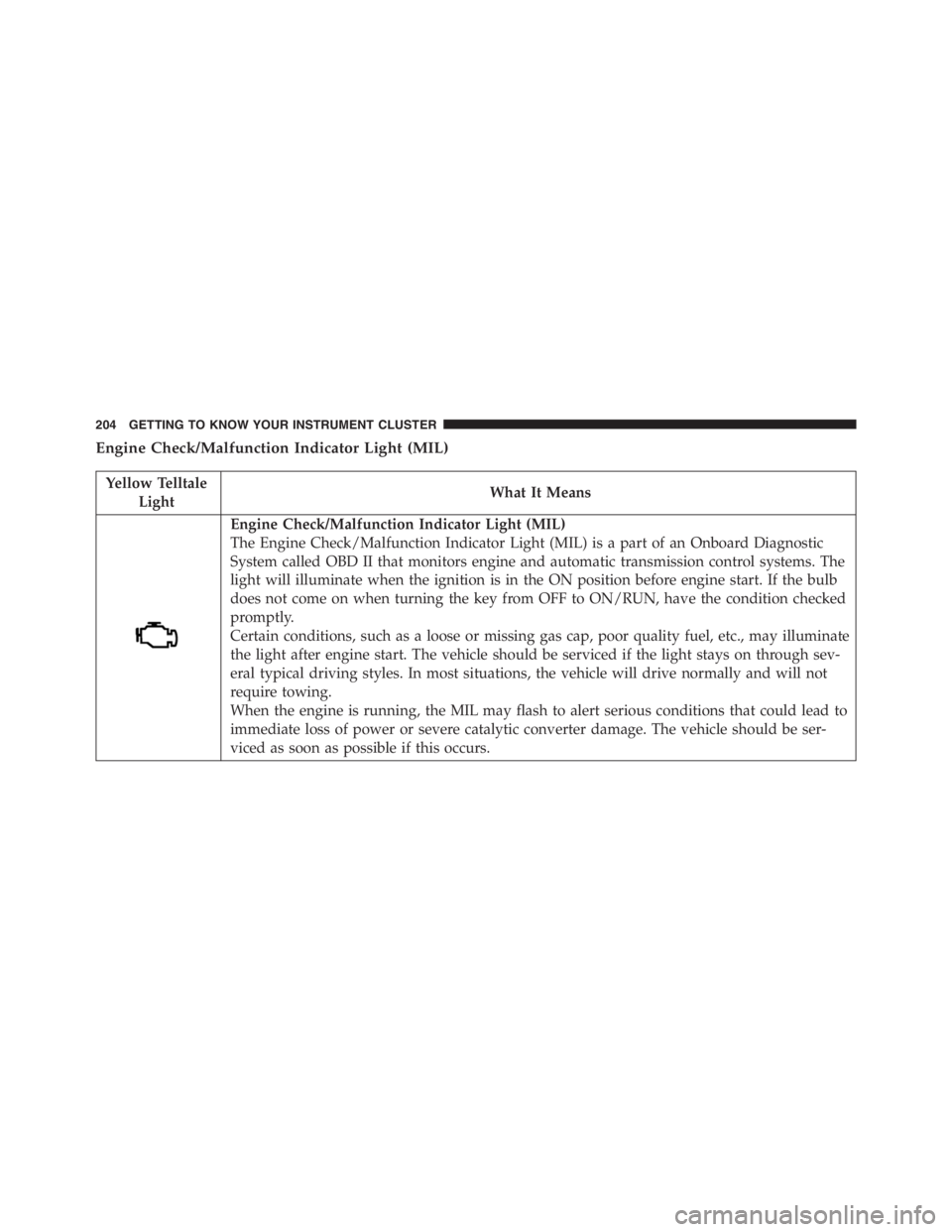
Yellow Telltale
LightWhat It Means
Engine Check/Malfunction Indicator Light (MIL)
The Engine Check/Malfunction Indicator Light (MIL) is a part of an Onboard Diagnostic
System called OBD II that monitors engine and automatic transmission control systems. The
light will illuminate when the ignition is in the ON position before engine start. If the bulb
does not come on when turning the key from OFF to ON/RUN, have the condition checked
promptly.
Certain conditions, such as a loose or missing gas cap, poor quality fuel, etc., may illuminate
the light after engine start. The vehicle should be serviced if the light stays on through sev-
eral typical driving styles. In most situations, the vehicle will drive normally and will not
require towing.
When the engine is running, the MIL may flash to alert serious conditions that could lead to
immediate loss of power or severe catalytic converter damage. The vehicle should be ser-
viced as soon as possible if this occurs.
204 GETTING TO KNOW YOUR INSTRUMENT CLUSTER
Page 208 of 688

Yellow Telltale
LightWhat It Means
Glow Plug Indicator Light
To prevent possible engine damage while starting at low temperatures, this vehicle will in-
hibit engine cranking and this icon will blink when the ambient temperature is less than
–35° C and the oil temperature sensor reading indicates an engine block heater has not been
used. The message “plug in engine heater” will be displayed in the instrument cluster when
the ambient temperature is below -32° C at the time the engine is shut off as a reminder.
Low Fuel Indicator Light
Yellow Telltale
LightWhat It Means
Low Fuel Indicator Light
When the fuel level reaches approximately 1.3–1.8 gal (5–7 L) this light will turn on, and re-
main on until fuel is added.
206 GETTING TO KNOW YOUR INSTRUMENT CLUSTER
Page 339 of 688
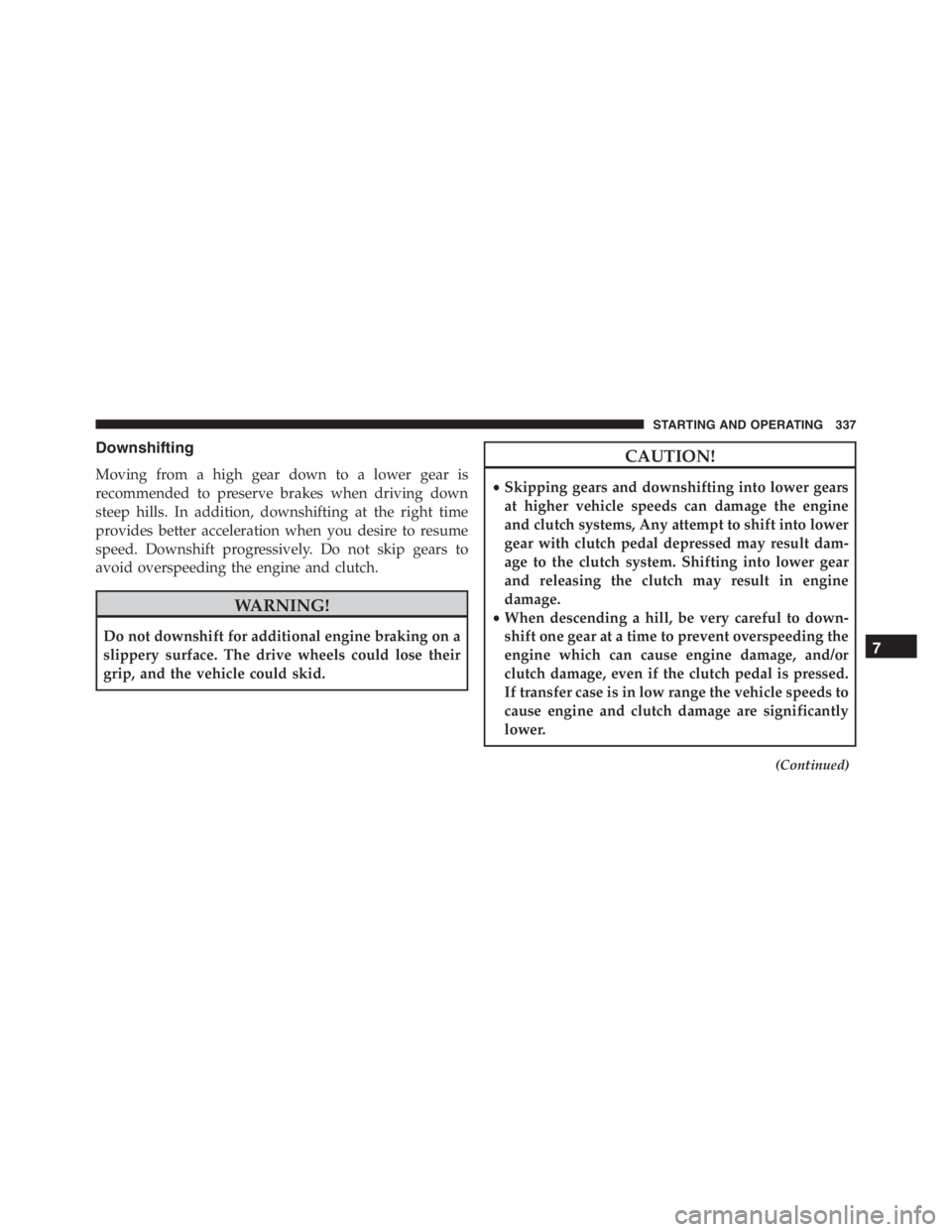
CAUTION!
•Skipping gears and downshifting into lower gears
at higher vehicle speeds can damage the engine
and clutch systems, Any attempt to shift into lower
gear with clutch pedal depressed may result dam-
age to the clutch system. Shifting into lower gear
and releasing the clutch may result in engine
damage.
•When descending a hill, be very careful to down-
shift one gear at a time to prevent overspeeding the
engine which can cause engine damage, and/or
clutch damage, even if the clutch pedal is pressed.
If transfer case is in low range the vehicle speeds to
cause engine and clutch damage are significantly
lower.
(Continued)
STARTING AND OPERATING 337
Page 340 of 688
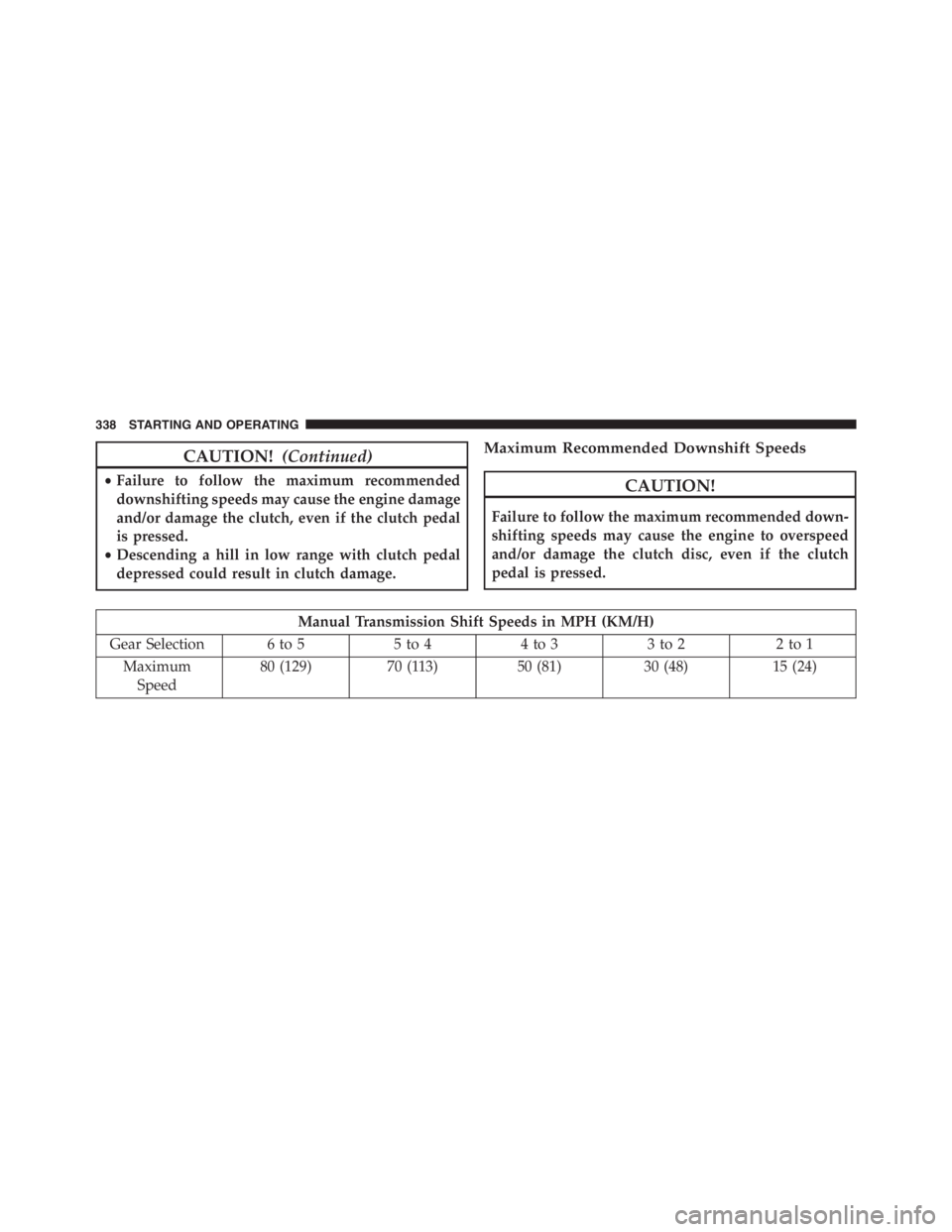
CAUTION!
Failure to follow the maximum recommended down-
shifting speeds may cause the engine to overspeed
and/or damage the clutch disc, even if the clutch
pedal is pressed.
Manual Transmission Shift Speeds in MPH (KM/H)
Gear Selection 6 to 5 5 to 4 4 to 3 3 to 2 2 to 1
Maximum
Speed80 (129) 70 (113) 50 (81) 30 (48) 15 (24)
338 STARTING AND OPERATING
Page 426 of 688

CAUTION!
•Do not tow a trailer at all during the first 500 miles
(805 km) the new vehicle is driven. The engine, axle
or other parts could be damaged.
•Then, during the first 500 miles (805 km) that a
trailer is towed, do not drive over 50 mph (80 km/h)
and do not make starts at full throttle. This helps
the engine and other parts of the vehicle wear in at
the heavier loads.
Towing Requirements — Tires
•Do not attempt to tow a trailer while using a compact
spare tire.
•Proper tire inflation pressures are essential to the safe
and satisfactory operation of your vehicle. Refer to
“Tires – General Information” in “Starting And Oper-
ating” for proper tire inflation procedures.
424 STARTING AND OPERATING
Page 504 of 688

CAUTION!
Failure to follow these procedures could result in
damage to the charging system of the booster vehicle
or the discharged vehicle.
Connecting The Jumper Cables
1. Connect the positive(+)end of the jumper cable to the
positive(+)post of the discharged vehicle.
2. Connect the opposite end of the positive(+)jumper
cable to the positive(+)post of the booster battery.3. Connect the negative(-)end of the jumper cable to the
negative(-)post of the booster battery.
4. Connect the opposite end of the negative(-)jumper
cable to a good engine ground (exposed metal part of
the discharged vehicle’s engine) away from the battery
and the fuel injection system.
Page 507 of 688
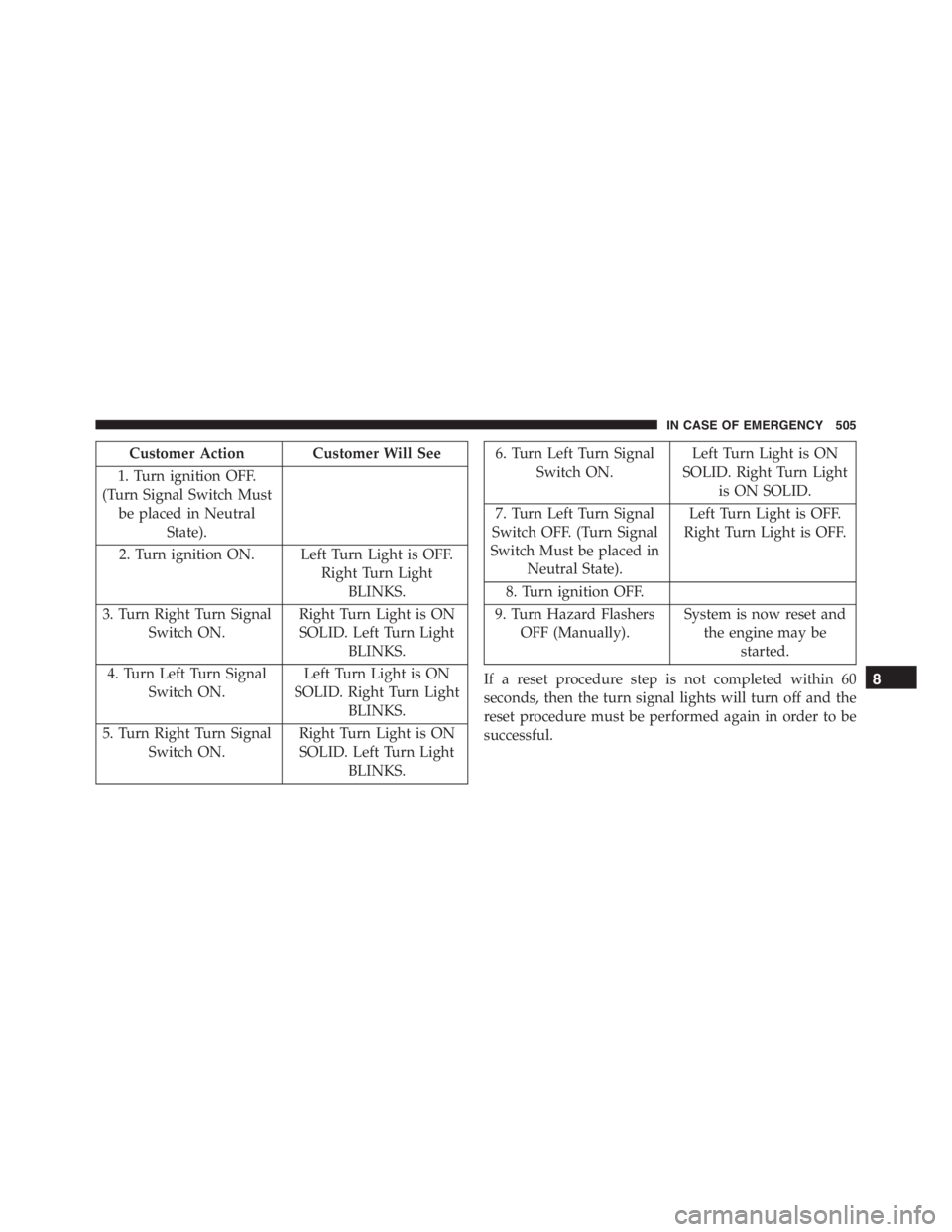
6. Turn Left Turn Signal
Switch ON.Left Turn Light is ON
SOLID. Right Turn Light
is ON SOLID.
7. Turn Left Turn Signal
Switch OFF. (Turn Signal
Switch Must be placed in
Neutral State).Left Turn Light is OFF.
Right Turn Light is OFF.
8. Turn ignition OFF.
9. Turn Hazard Flashers
OFF (Manually).System is now reset and
the engine may be
started.
If a reset procedure step is not completed within 60
seconds, then the turn signal lights will turn off and the
reset procedure must be performed again in order to be
successful.
IN CASE OF EMERGENCY 505
Page 528 of 688
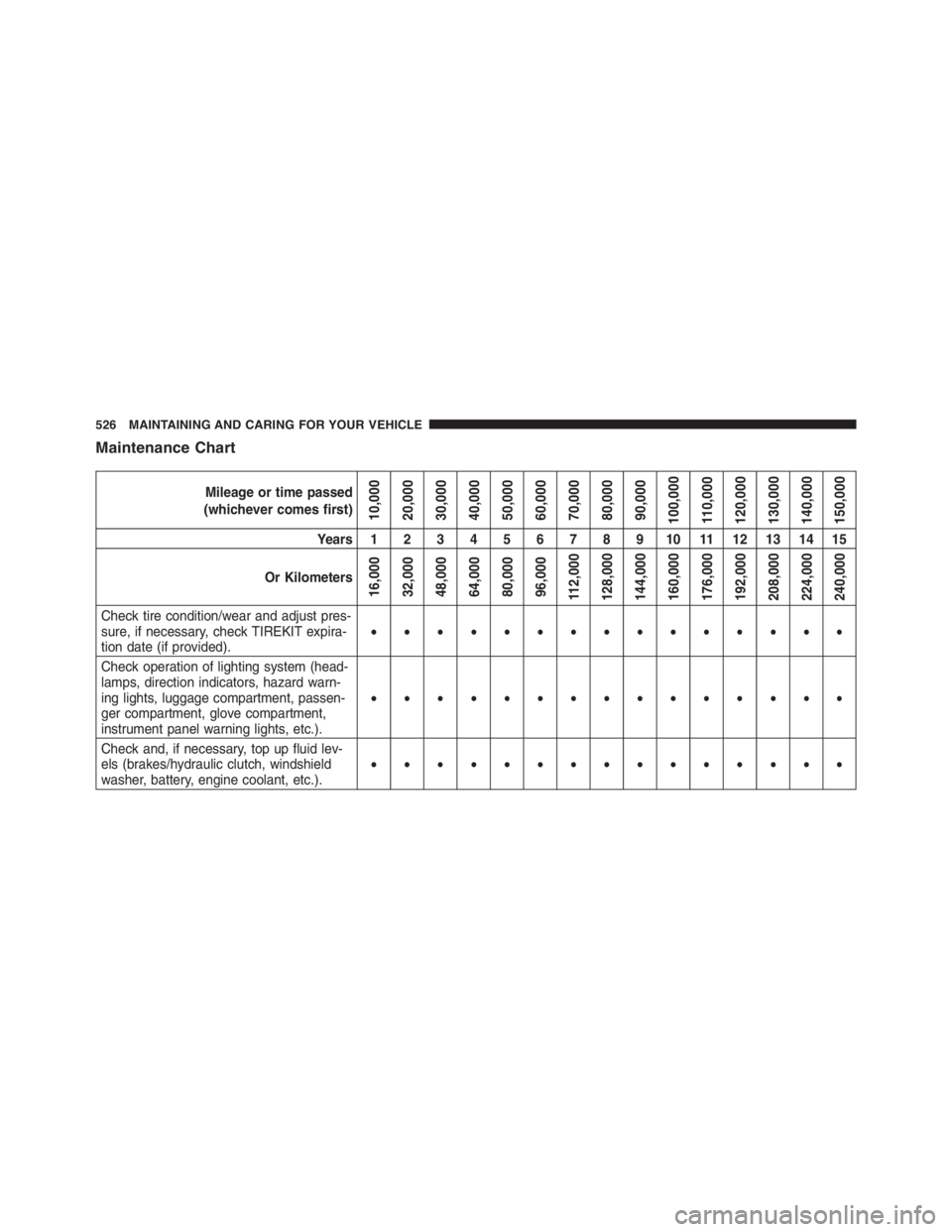
Mileage or time passed
(whichever comes first)
10,000
20,000
30,000
40,000
50,000
60,000
70,000
80,000
90,000
100,000
110,000
120,000
130,000
140,000
150,000
Years123456789101112131415
Or Kilometers
16,000
32,000
48,000
64,000
80,000
96,000
112,000
128,000
144,000
160,000
176,000
192,000
208,000
224,000
240,000
Check tire condition/wear and adjust pres-
sure, if necessary, check TIREKIT expira-
tion date (if provided).•••••••••••••••
Check operation of lighting system (head-
lamps, direction indicators, hazard warn-
ing lights, luggage compartment, passen-
ger compartment, glove compartment,
instrument panel warning lights, etc.).•••••••••••••••
Check and, if necessary, top up fluid lev-
els (brakes/hydraulic clutch, windshield
washer, battery, engine coolant, etc.).•••••••••••••••
526 MAINTAINING AND CARING FOR YOUR VEHICLE
Page 548 of 688
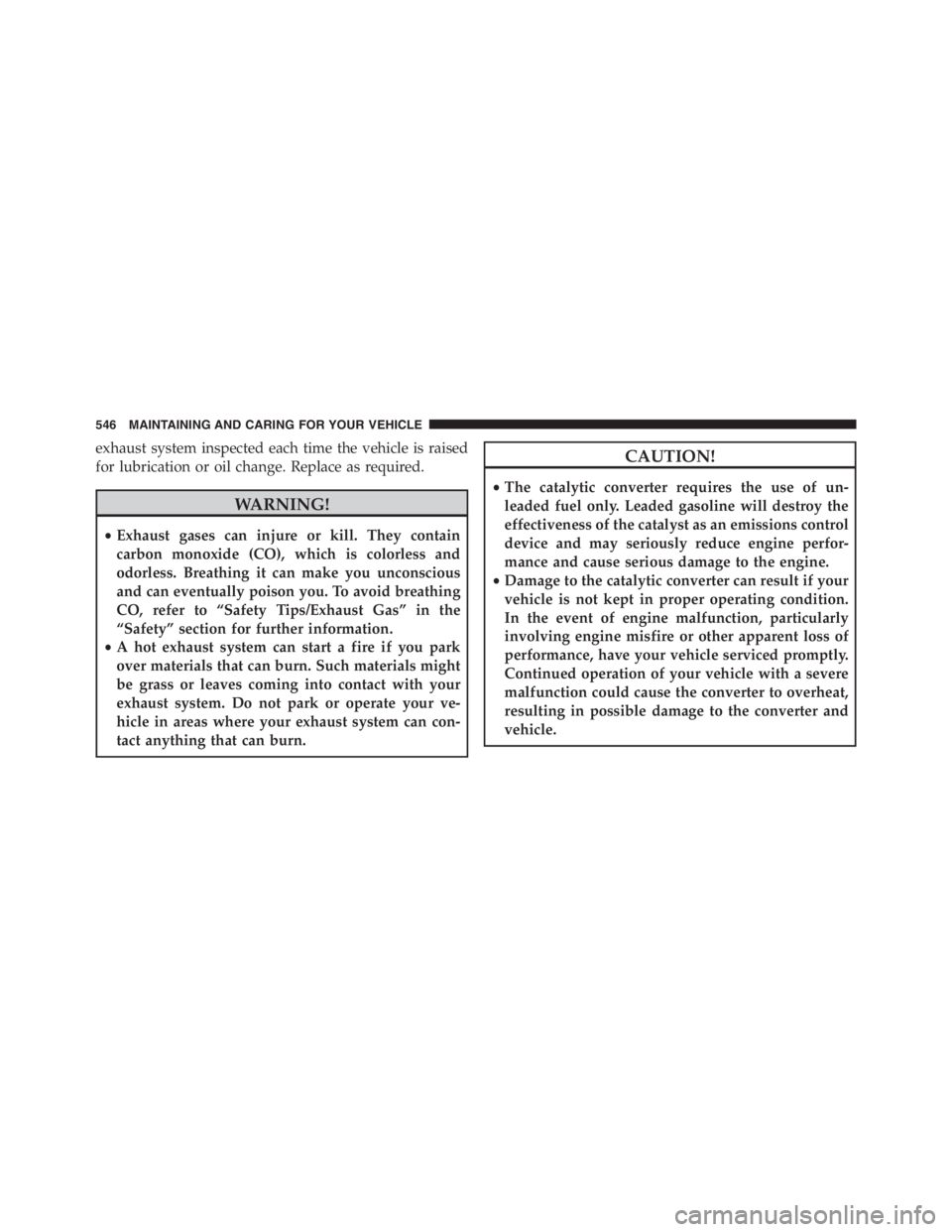
CAUTION!
•The catalytic converter requires the use of un-
leaded fuel only. Leaded gasoline will destroy the
effectiveness of the catalyst as an emissions control
device and may seriously reduce engine perfor-
mance and cause serious damage to the engine.
•Damage to the catalytic converter can result if your
vehicle is not kept in proper operating condition.
In the event of engine malfunction, particularly
involving engine misfire or other apparent loss of
performance, have your vehicle serviced promptly.
Continued operation of your vehicle with a severe
malfunction could cause the converter to overheat,
resulting in possible damage to the converter and
vehicle.
546 MAINTAINING AND CARING FOR YOUR VEHICLE